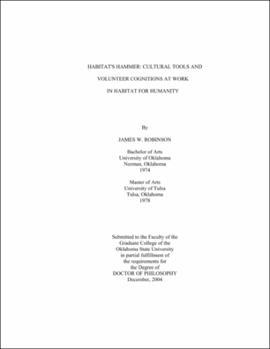| dc.contributor.advisor | Van Delinder, Jean | |
| dc.contributor.author | Robinson, James W. | |
| dc.date.accessioned | 2013-11-26T08:28:03Z | |
| dc.date.available | 2013-11-26T08:28:03Z | |
| dc.date.issued | 2004-12 | |
| dc.identifier.uri | https://hdl.handle.net/11244/7012 | |
| dc.description.abstract | Scope and Method of Study: This study explored the interplay between Habitat for Humanity's (Habitat's) culture and social structure and its volunteer members' attributions toward the causes of poverty. An index was developed to explore member attributions for the causes of poverty and administered to thirty-seven new volunteers for a local Habitat affiliate (treatment group) and a group of thirty-five individuals not volunteering for Habitat (control group) at the beginning of their volunteer service (pretest) and again three months afterward (posttest). The data produced by this quasi-experimental pretest posttest with nonequivalent control group design was statistically analyzed using analysis of variance. A biographical analysis of the major, publicly available written works of Habitat founder and president, Millard Fuller, was conducted using a template developed from poverty attribution literature and neoinstitutionalist theory to determine the nature of Habitat for Humanity's cultural and structural elements. Finally, semi-structured interviews were conducted with a second set of twelve Habitat volunteers and analyzed using portions of the template developed above. | |
| dc.description.abstract | Findings and Conclusions: Habitat's culture exhibits settled times and contains contested territory where struggles between differing attributional styles occur. This mitigates the influence of the organization on volunteer attributions. Low-income program participants are moved into higher and higher status typification categories-from "poor people" to "deserving poor" to "the chosen" to "partners" and eventually "homeowners". This transformation process may confound individual volunteers' attributions toward the causes of poverty by allowing them to think of program participants as different from the general population of "the poor." The organization may influence some volunteers' attributions, over a long period of time, but may not affect the poverty cause attributions of new volunteers during early months of service. Members' cognitions may influence Habitat as much or more than the organization influences members' cognitions. Because new volunteers often experience the culture of Habitat as it is verbalized and practiced by committed volunteers and committed volunteers sometimes re-formulate cultural elements within their cognitions to fit more comfortably with other cognitive elements they hold, such transmissions may neutralize elements of the organization's culture, decreasing the influence of Habitat upon the new volunteer. | |
| dc.format | application/pdf | |
| dc.language | en_US | |
| dc.rights | Copyright is held by the author who has granted the Oklahoma State University Library the non-exclusive right to share this material in its institutional repository. Contact Digital Library Services at lib-dls@okstate.edu or 405-744-9161 for the permission policy on the use, reproduction or distribution of this material. | |
| dc.title | Habitat's Hammer: Cultural tools and volunteer cognitions at work in Habitat for Humanity | |
| dc.contributor.committeeMember | Knottnerus, David | |
| dc.contributor.committeeMember | Caniglia, Beth S. | |
| dc.contributor.committeeMember | Arquitt, George E. | |
| dc.contributor.committeeMember | Shook, John | |
| osu.filename | Robinson_okstate_0664D_1081.pdf | |
| osu.accesstype | Open Access | |
| dc.type.genre | Dissertation | |
| dc.type.material | Text | |
| dc.subject.keywords | political contributions | |
| dc.subject.keywords | campaign finance | |
| dc.subject.keywords | democracy | |
| dc.subject.keywords | interest groups | |
| thesis.degree.discipline | Sociology | |
| thesis.degree.grantor | Oklahoma State University | |
